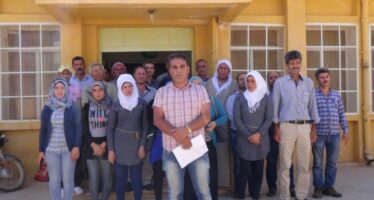Parliamentary commission adopts Uludere report, opposition cries foul
![]()
TODAYSZAMAN.COM
?STANBUL
A Turkish Parliamentary commission has adopted a controversial report on the killing of 34 civilians in Uludere in late 2011 despite staunch criticism from opposition parties.
Parliament’s Human Rights Commission adopted the report, prepared by the sub-commission tasked with investigating the botched air strike along the border with Northern Iraq, with a simple majority vote on Wednesday.
Ruling Justice and Development Party (AK Party) Ankara deputy Ülker Güzel said in remarks aimed at backing the report that the Turkish state would not kill its own citizens “intentionally.”
The investigation into the killing of 34 civilians by Turkish jets on Dec. 28, 2011, found in its report that the killings were not deliberate, although it listed numerous flaws in decision-making leading to the incident.
“It has been agreed that no evidence has been found that would suggest that there was deliberate action in the incident after research and examination of this issue which has deeply saddened and shaken the whole country,” said the 84-page report, made public last Friday.
The 34 civilians in Uludere, a district of ??rnak, were killed after they were mistaken for terrorists of the Kurdistan Workers’ Party (PKK). The civilians were smuggling goods from Northern Iraq as part of their livelihood. The incident led to outrage across the country.
Kayseri deputy of the opposition National Movement Party (MHP) Yusuf Halaço?lu said after the commission endorsed the report that anyone examining the relevant footage from Turkey’s Heron drones can understand that those observed are not terrorists and questioned why the Turkish military could not appropriately read the behavior of the groups walking in the area.
The report said that beginning one month before the air strike, authorities noticed unusual movement from terrorists in the region where the strike took place and there have been a number of intelligence reports that shore up this judgment.
The report found that intelligence showed there were 16 groups of terrorists in the area in December 2010, while this number had reached 37 a year later, just before the air strike.
The commission’s report said authorities received up to 30 intelligence tips that the terrorists, including their leaders, were frequently moving in the region in groups of 10 to 134, taking shelter in mountains close to the Turkish border, and were planning significant attacks.
The report said these intelligence reports had put military authorities on constant alert and that such general intelligence reports were delivered to all military units, putting these units on high alert with expectations of a major attack.
The report also said that US unmanned aerial vehicles (UAVs) initially did the intelligence gathering in areas of their jurisdiction and were replaced by Turkish UAVs in areas that fell under Turkish jurisdiction. It said a US drone observing Kandil Mountain in Iraq on the Iran border, the main PKK base, was dispatched to the Haftanin area to aid the intelligence gathering. When the US drone arrived in the area, a group of people suspected to be PKK terrorists had already entered into the area of Turkish jurisdiction for observation and the US drone left the area.
The Turkish UAV observed the group with vehicles, animals and people approaching Turkey for three hours. Experts and commission members who examined the intelligence recordings said it is impossible to identify these people as terrorists but their movement, combined with earlier experiences, caused suspicions that they were terrorists.
Nevertheless, the report said the group at times gathered in high, open areas to make phone calls without any security measures. The recordings showed that the behavior of the group did not fit a group of armed people planning an attack and that they instead acted freely. However, the report said it was easier after the fact to decipher from the footage that the group was not planning attacks.
The report said that there was enough time for authorities, using better coordination, to determine in the proper way whether the group was composed of terrorists. “This opportunity was not well used,” the report underlined.
The report stressed that after the first bombs were unleashed on the group in the front, another group, estimated to be 1,100 meters behind, didn’t run and try to hide — something terrorists would do — despite the noises of warplanes. It said this and other behavior, along with the position of the group, clearly demonstrates that it should have been possible to determine the group of people killed in the air strike were not terrorists.
The report also made it clear that it was possible with the surveillance technology to distinguish people and animals, but not to distinguish between armed terrorists and civilians.
Halaço?lu argued that Turkish army chief should have been aware of the situation because all cross-border operations could take place only by direct order of the Chief of General Staff.
AK Party Ad?yaman deputy Mehmet Metiner told the opposition that the way to prevent future incidents like Uludere is to support the current Kurdish settlement process. Noting that the commission is not a court, Metiner said there is nothing to criticize in the report.
Related Articles
Executive Council declares Shebha Canton
![]()
The Executive Council of Shehba Region released a press statement to officially declared the Shehba Canton affiliated to Efrîn Federal Region
BDP Congress begun in Ankara
![]()
Peace and Democratic Autonomy are the main topics of Congress The 2nd Congress of the Peace and Democracy Party (BDP),
Block deputies: We will not go to Parliament
![]()
Labour, Democracy and Freedom Block deputies has decided not to go to Parliament Labor, Democracy and Freedom Block deputies have



